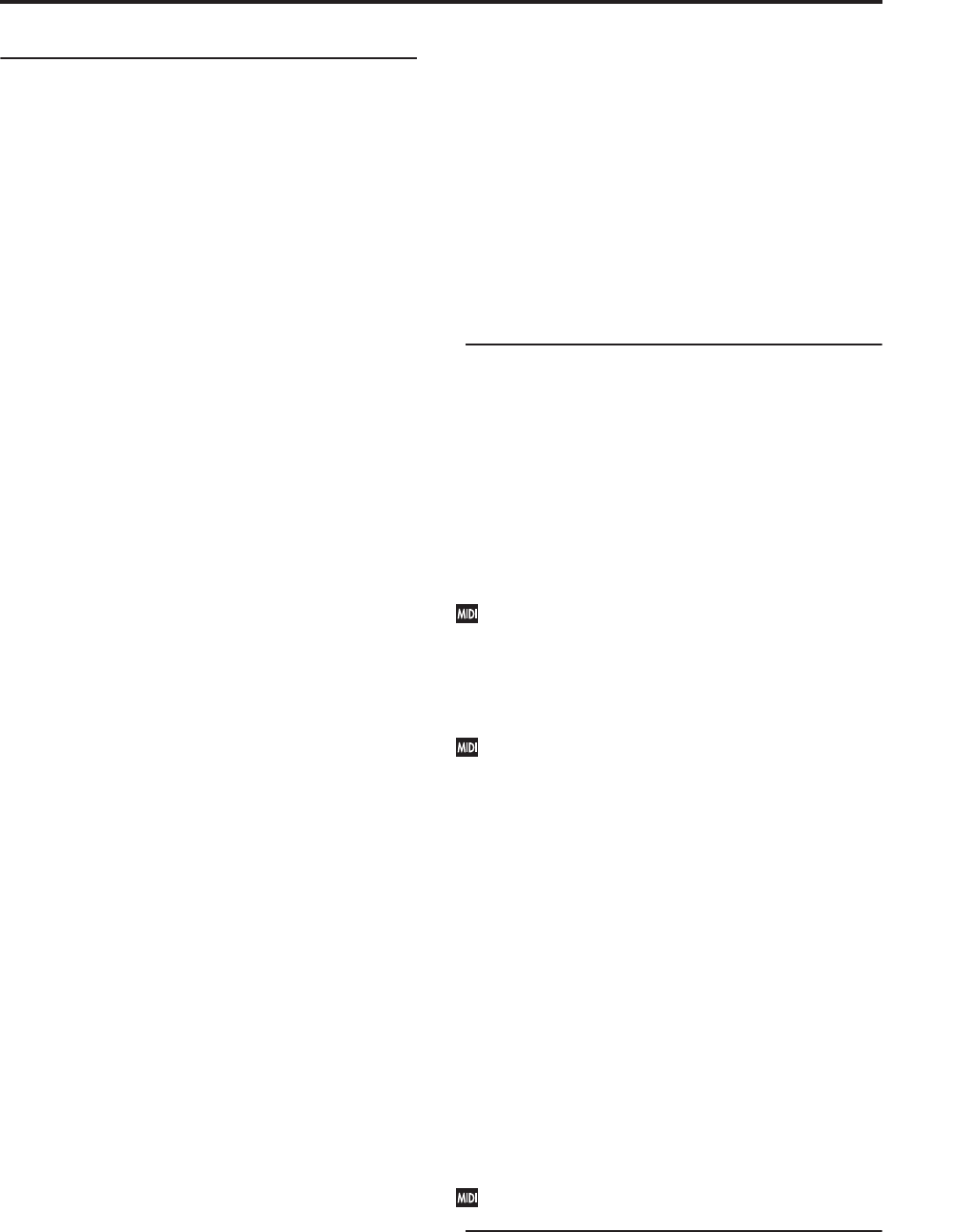
Program P4: Oscillators & Filters 4-1: Oscillators & Filters
287
4-1b: High Pass Filter
HPF
This filter cuts out the parts of the sound which are
lower than the cutoff frequency. You can use this to
make timbres sound thinner or more buzzy, or to
enhance bass sounds (see “Using the HPF as a sub-
oscillator for bass sounds,” below).
FREQUENCY [0.00…10.00]
This controls the cutoff frequency of the Highpass
Filter.
PEAK [0.00…10.00]
Peak controls the resonance of the filter, which
emphasizes the frequencies around the cutoff
frequency.
When this is set to 0, there is no emphasis, and
frequencies beyond the cutoff will simply diminish
smoothly.
At medium settings, the resonance will alter the timbre
of the filter, making it sound more nasal, or more
extreme.
At very high settings, the resonance can be heard as a
separate, whistling pitch. Near the maximum setting,
the filter will self-oscillate.
PEAK and filter saturation
If the input level is high, raising the PEAK setting will
cause increasing amounts of saturation and overdrive,
creating a more aggressive tone. To control this, raise
or lower the input level at the source–for instance, in
the VCO MIXER.
Using the HPF as a sub-oscillator for bass sounds
With PEAK set relatively high, and FREQUENCY
turned down low, the HPF can–somewhat counter-
intuitively– be used to enhance low-end harmonics,
creating thunderously deep bass sounds. To do so:
1. Start with a simple bass sound.
2. On the Patch Panel, connect the KBD CV OUT to
the HPF CUTOFF FREQ input.
This allows the HPF to track the keyboard.
3. Set the HPF PEAK to around 7 or 8.
4. Set the HPF FREQUENCY very low, but not quite
at 0.
5. Set the EG2/EXT knob to about 5.
6. While playing the sound, adjust the FREQUENCY
and EG2/EXT settings so that the filter resonance
tracks the pitch correctly in the intended playing
range.
With this setup, the resonance will only match the
oscillator pitches over about one and a half octaves.
CUTOFF FREQUENCY MODULATION (HPF)
MG/T.EXT [0.00…10.00]
If nothing is connected to the patch panel’s TOTAL
input jack, this adjusts the depth to which the MG will
modulate the filter cutoff frequency.
If a cable is connected to the TOTAL input jack, this
controls the depth of modulation from that signal.
For more information, see “TOTAL input jack” on
page 295.
EG2/EXT [0.00…10.00]
If nothing is connected to the HPF’s CUTOFF FREQ
input jack, this adjusts the depth to which EG 2 will
modulate the filter cutoff frequency.
If a cable is connected to the HPF’s CUTOFF FREQ
input jack, this controls the depth of modulation from
that signal.
4-1c: Low Pass Filter
LPF
The Lowpass Filter cuts out the parts of the sound
which are higher than the cutoff frequency. This is the
most common type of filter, and is used to make bright
timbres sound darker.
FREQUENCY [0.00…10.00]
This controls the cutoff frequency of the Lowpass
Filter.
This is scaled by MIDI CC#74.
PEAK [0.00…10.00]
Peak controls the resonance of the filter, which
emphasizes the frequencies around the cutoff
frequency. For more information, see “PEAK,” above.
This is scaled by MIDI CC#71.
CUTOFF FREQUENCY MODULATION (LPF)
MG/T.EXT [0.00…10.00]
If nothing is connected to the TOTAL input jack, this
adjusts the depth to which the MG will modulate the
filter cutoff frequency.
If a cable is connected to the TOTAL input jack, this
controls the depth of modulation from that signal.
For more information, see “TOTAL input jack” on
page 295.
EG2/EXT [0.00…10.00]
If nothing is connected to the LPF’s CUTOFF FREQ
input jack, this adjusts the depth to which EG 2 will
modulate the filter cutoff frequency.
If a cable is connected to the LPF’s CUTOFF FREQ
input jack, this controls the depth of modulation from
that signal.
This is scaled by MIDI CC#79.
4-1d: PITCH
BEND RANGE [0.00…12.00]
This sets the maximum amount of pitch bend up and
down, in semitones and cents, as controlled by JS X. To
use another AMS source for pitch bend, modulate the
TRANSPOSE parameter instead.
BEND RANGE is not modulatable via AMS.


















